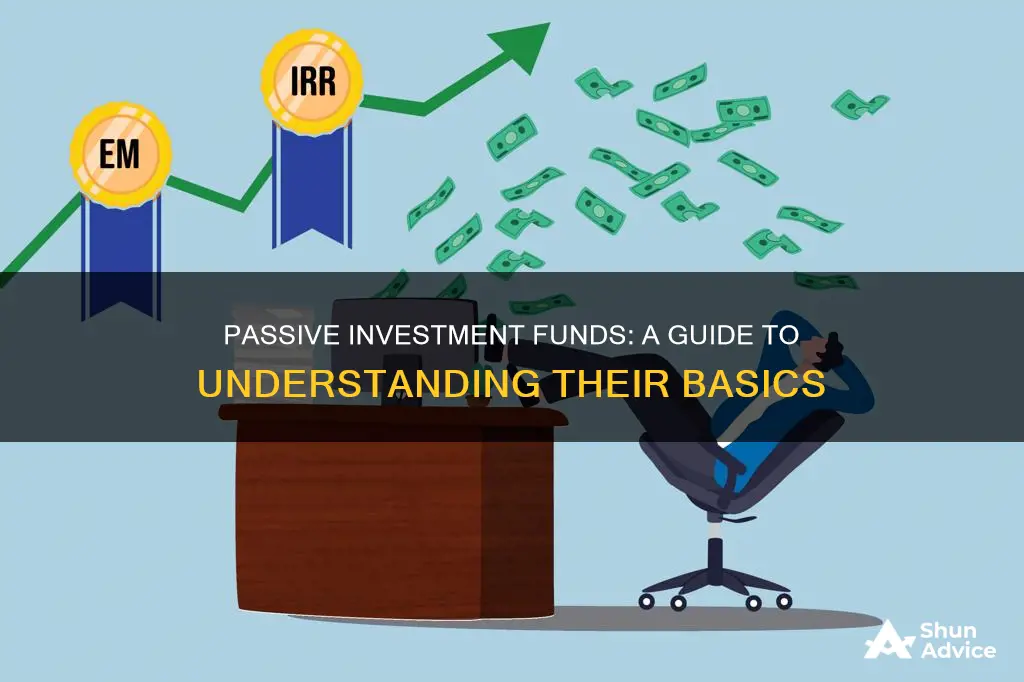
Passive investment funds are a type of investment strategy that aims to maximise returns by minimising the costs of buying and selling securities. Passive investing is typically done by investing in a mutual fund or exchange-traded fund (ETF) that mirrors the composition and performance of a specific index, such as the S&P 500. This type of investing is called passive because fund managers do not have to actively hunt for investments; they simply buy and sell the investments that their target benchmark trades. Passive investing is often associated with lower fees and greater tax efficiency than active investing, but it can result in smaller short-term returns.
| Characteristics | Values |
|---|---|
| Definition | An investment strategy that aims to maximise returns by minimising the costs of buying and selling securities. |
| Common methods | Index investing, mutual funds, exchange-traded funds (ETFs) |
| Buying and selling | Less buying and selling, often resulting in investors buying indexed or other mutual funds |
| Costs | Lower fees, greater tax efficiency |
| Returns | Smaller short-term returns compared to active investing |
| Risk | Less risk over a longer period of time |
| Management | Requires less management |
| Performance | Attempts to match or track market performance |
| Flexibility | Less flexible than active investing |
What You'll Learn
- Passive investment funds are designed to mirror the performance of an index by holding the same or similar securities in the same proportions
- Passive investment funds are most common on the equity market, but they are becoming more common in other investment types, including bonds, commodities and hedge funds
- Passive investment funds are often less expensive than active funds, with lower fees and transaction costs
- Passive investment funds are typically less complex than active funds, as they do not require extensive research
- Passive investment funds are less risky than active funds, as they are not trying to beat the market

Passive investment funds are designed to mirror the performance of an index by holding the same or similar securities in the same proportions
Passive investment funds are a form of passive investing or passive management, which is an investment strategy that tracks a market-weighted index or portfolio. Passive investment funds are designed to mirror the performance of an index by holding the same or similar securities in the same proportions. This means that the fund will rise and fall with the index it is tracking. For example, a passive fund mirroring the S&P 500 index will buy and sell the same stocks that are in the S&P 500, in the same proportions.
Passive funds are also known as index funds, and they do not attempt to outperform the index they are tracking. Instead, they aim to replicate its performance. The managers of these funds only buy or sell securities when necessary to correspond with the index. This means that trades within the portfolio are automated, with little to no human decision-making involved. This makes passive funds a popular choice for investors seeking a simple and straightforward investment approach.
Passive funds have lower fees than actively managed funds, as they do not require costly research and analysis. Passive funds also tend to have lower management fees, as they are designed to minimise the costs of buying and selling securities. With lower fees, an investor in a passive fund can expect higher returns than a similar fund with higher management fees and transaction costs.
Passive funds are most common in the equity market, where index funds track a stock market index. However, they are becoming more common in other investment types, including bonds, commodities, and hedge funds. The most popular method for passive investing is to buy an index fund that mimics the performance of an externally specified index.
Investment Trust vs Fund: What's the Difference?
You may want to see also

Passive investment funds are most common on the equity market, but they are becoming more common in other investment types, including bonds, commodities and hedge funds
Passive investment funds are a long-term strategy for building wealth by buying securities that mirror stock market indexes and holding them for the long term. This strategy aims to maximise returns by minimising the costs of buying and selling securities. Passive investing is typically done by investing in a mutual fund or exchange-traded fund (ETF) that mimics the index's holdings.
Index investing is the most common form of passive investing. With index investing, investors seek to replicate and hold a broad market index or indices. This can be done by investing in a mutual fund or ETF that tracks a broad market index, such as the S&P 500. The introduction of index funds in the 1970s made it much easier to achieve returns in line with the market.
Another way to passively invest in the equity market is through exchange-traded funds (ETFs). ETFs are a type of mutual fund that trades on an exchange like a stock. ETFs that track major indices allow investors to trade index funds as if they were stocks. This makes the process of passive investing even simpler and more accessible.
While passive investing is most common in the equity market, it is becoming more popular in other investment types. For example, investors can passively invest in bonds by focusing on bonds that generate interest. Real estate investment trusts (REITs) are another way to passively invest in real estate, as they pay out dividends to investors.
Commodities are also an option for passive investing. For example, investors can put their money into dividend-paying stocks, which funnel a portion of company profits back to investors in the form of dividends.
Hedge funds can also be passively invested in. A robo-advisor, for example, uses computer algorithms and software to choose investments that align with the investor's goals. This allows for a more hands-off approach to investing, which may be attractive to those who don't have the time or interest in actively managing their investments.
Pershing Square Hedge Fund: A Guide to Investing
You may want to see also

Passive investment funds are often less expensive than active funds, with lower fees and transaction costs
Passive investment funds are a strategy that aims to maximise returns by minimising the costs of buying and selling securities. Passive investment funds are often less expensive than active funds, with lower fees and transaction costs.
Passive investment funds are less expensive because they are designed to mirror the performance of a specific market index, such as the S&P 500 or Dow Jones Industrial Average. This means that passive fund managers do not need to actively hunt for investments or conduct extensive research and analysis, which are typical requirements for active fund managers. Instead, passive fund managers simply buy and sell the investments that their target benchmark trades. This passive approach reduces the fees and transaction costs that are typically associated with active fund management.
In addition to lower fees and transaction costs, passive investment funds also benefit from economies of scale, as they are often larger on average than actively managed funds. This further contributes to the cost-effectiveness of passive investment funds.
The lower costs associated with passive investment funds can result in higher returns for investors over time. By minimising expenses and transaction costs, passive investment funds can provide superior after-tax results over medium to long time horizons. This makes passive investment funds an attractive option for investors seeking a cost-effective, hands-off approach to investing.
While passive investment funds offer the advantage of lower fees and costs, it is important to consider the trade-offs. Passive investment funds may have limited flexibility and typically do not aim to outperform the market. Instead, they focus on mirroring the performance of a specific index, which may result in smaller short-term returns compared to active investing.
Key Factors for Investors to Consider in Mutual Funds
You may want to see also

Passive investment funds are typically less complex than active funds, as they do not require extensive research
Passive investment funds are a type of investment strategy that tracks a market-weighted index or portfolio. They are designed to mirror the performance of a specific index, such as the S&P 500, by holding the same or similar securities in the same proportions. This means that passive funds do not require extensive research as they simply aim to replicate the index they are tracking. This is in contrast to active funds, which involve a fund manager actively picking and choosing investments with the aim of outperforming a designated index or benchmark.
Passive investment funds are typically less complex than active funds as they do not require extensive research and analysis. Passive funds are often referred to as "index funds" because they track a particular index and aim to mirror its performance. The managers of passive funds only buy or sell securities as necessary to correspond with the index, which results in lower fees and costs for investors. Passive funds have lower fees because they do not require the same level of research and analysis as active funds, and they also benefit from economies of scale as they tend to be larger than actively managed funds.
The passive investment strategy is based on the efficient-market hypothesis, which postulates that market prices fully reflect all available information. This hypothesis suggests that it is impossible to consistently "beat the market" through active management. Passive investing also aligns with William Sharpe's zero-sum game theory, which states that the average investor will benefit more from reducing investment costs than from trying to beat the market.
Passive funds are typically less complex than active funds as they do not require the same level of human decision-making and expertise. Passive funds are often automated, with little to no human involvement in the trading process. This means that passive funds are more straightforward and easier to understand for investors. However, it is important to note that passive funds are limited to a specific index or set of investments, which can be a disadvantage if the index underperforms or if investors want more control over their investments.
In summary, passive investment funds are typically less complex than active funds as they do not require extensive research, analysis, or human decision-making. Passive funds aim to mirror the performance of a specific index, which results in lower fees and costs for investors. While passive funds offer a simpler and more cost-effective investment strategy, they may not be suitable for all investors, especially those seeking to outperform the market or wanting more control over their investments.
Axis Long Term Equity Fund: A Beginner's Guide to Investing
You may want to see also

Passive investment funds are less risky than active funds, as they are not trying to beat the market
Passive investment funds are a form of passive investing or passive management, which is an investment strategy that tracks a market-weighted index or portfolio. Passive investment funds are designed to mirror the performance of a specific index, such as the S&P 500, by holding the same or similar securities in the same proportions. This means that when the index rises and falls, so does the passive fund, and the fund buys and sells the same stocks as the index.
Passive investment funds are less risky than active funds as they are not trying to beat the market. Instead, they aim to replicate the performance of the market or a specific index. This means that passive funds are less susceptible to the risks associated with trying to outperform the market, such as higher management fees and transaction costs, which can eat into returns. Passive funds also benefit from lower fees and greater tax efficiency due to their buy-and-hold strategy and reduced trading.
Passive investment funds are also less complex than active funds as they do not require the same level of active management and decision-making. Passive funds simply mirror the composition and performance of a specific index, whereas active funds involve a portfolio manager or other active participant who actively buys and sells investments based on their short-term performance, attempting to beat average market returns. This hands-on approach requires a deeper analysis and expertise to navigate market volatility and make profitable decisions.
While passive funds may not offer the potential for higher returns that active funds promise, they do provide a more stable and less risky investment option. Passive funds are also more prevalent among retail investors and have historically earned more money than active investments. Additionally, passive funds offer greater diversification and lower fees, making them a popular choice for investors seeking a long-term, cost-effective investment strategy.
Selecting Investment Funds: A Comprehensive Guide
You may want to see also
Frequently asked questions
Passive investment, or passive management, is an investment strategy that tracks a market-weighted index or portfolio. The aim is to generate returns by minimising the costs of buying and selling securities. Passive investment is typically done through mutual funds or exchange-traded funds (ETFs) that mimic the composition and performance of a specific index, such as the S&P 500.
Passive investment funds offer several advantages, including ultra-low fees, transparency of assets, and tax efficiency due to their buy-and-hold strategy. They also provide good diversification and low management fees, resulting in higher returns compared to similar funds with higher fees.
Passive investment funds have limited flexibility as they are tied to a specific index or set of investments. They rarely beat the market and may result in smaller returns, especially during times of turmoil. Additionally, passive investors rely on fund managers to make decisions, which may be a disadvantage for those who want more control over their investments.
Active investment funds aim to outperform the market by actively selecting and managing investments through a hands-on approach. Active fund managers work with analysts and researchers to buy, hold, and sell stocks based on short-term performance and expectations. In contrast, passive investment funds simply aim to replicate the performance of a specified index, and they do not actively select or manage investments. Passive funds are generally less expensive and have lower fees than active funds.







